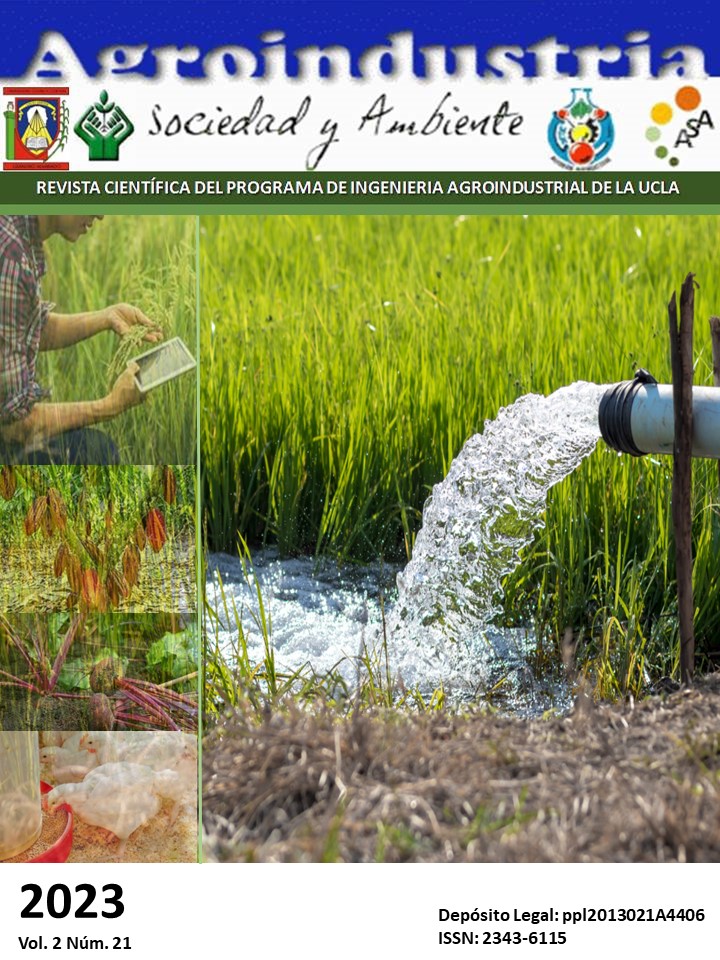Evaluation of natural dyes extracted from beets for their potential use in an isotonic drink
DOI:
https://doi.org/10.5281/zenodo.10389212Keywords:
betacyanins, betalains, betaxanthins, isotonic drink, natural dyesAbstract
With the objective of evaluating the dyes extracted from beetroots to incorporate them into an isotonic drink, a research work was conducted in four (4) phases. These dyes, being of natural origin, are ideal substitutes for artificial dyes and you can take advantage of their potential health benefits, such as their antioxidant and anti-cancer properties. The first phase consisted of the physicochemical characterization of the raw material, with results of 6.5 ± 0.1 pH, 5.0 ± 0.7 °Brix, 0.048 ± 0.004 % of titratable acidity and 89.8 ± 0.4 % humidity. The second was divided into two stages, selection of the mixture of solvents and the proportion vegetable: solvents mixture, the mixture of proportions by volume selected was 62: 37.7: 0.3 of water, ethanol and acetic acid and the optimal vegetable: solvent mixture ratio was the 1:1 ratio, they were extracted with concentrations (mg/L) of 176 ± 4 and 173 ± 2 of betacyanins and betaxanthins, respectively. Anthocyanins were not detected. In phase three (3), four (4) isotonic drinks were formulated, obtaining that the formula with the highest acceptability was that of 0.1% dye extract. For the final phase, the drinks were stored for two (2) weeks at room temperature (23°C) and their color was measured in the LAB space, the "L" parameter increased from the second day of storage, while the parameter "a" decreased, in the case of "b", it had constant values for two of the drinks evaluated. It was concluded that the natural dyes extracted from beetroots can be used in the preparation of an isotonic drink.
Downloads
References
Alvarez, R. y Veliz, J. (2015). Microencapsulación del extracto de betanina del Beta vulgaris por atomización y evaluación de sus propiedades funcionales como colorante natural. Universidad Nacional del Centro del Perú. http://hdl.handle.net/20.500.12894/1930
Belmonte, J. L., Arroyo, I., Vázquez, M., Cruz, D., y Peña, E. (2016). Colorantes artificiales en alimentos. Revista Naturaleza y Tecnología. 10 (15). Obtenido de http://quimica.ugto.mx/index.php/nyt/article/view/204
Comisión Venezolana de Normas Industriales (2022). Alimentos. Determinación del pH (Acidez Iónica) (COVENIN 1315-2021). https://sigbs.sencamer.gob.ve/cgi-bin/koha/opac-retrieve-file.pl?id=61ec330cd0abb242cb43d0c0cdc8e9ec
Comisión Venezolana de Normas Industriales (2017). Alimentos para animales. Determinación de Humedad (COVENIN 1156-2017). https://sigbs.sencamer.gob.ve/cgi-bin/koha/opac-retrieve-file.pl?id=6663986fcb7ebd0396a2a245a052886a
Comisión Venezolana de Normas Industriales (1977). Determinación de Acidez titulable.
Comisión Venezolana de Normas Industriales (1983). Determinación de Sólidos Solubles.
Dias, S., Castanheira, E., Fortes, G., Pereira, D., y Goncalves, S. (2020). Natural Pigments of Anthocyanin and Betalain for Coloring Soy-Based Yogurt Alternative. Foods, 9(6), 771. doi:10.3390/foods9060771
Gironés, A., Moreno, D., Garcia, C., y Villaño, D. (2013). New isotonic drinks with antioxidant and biological capacities from berries (maqui, açaí and blackthorn) and lemon juice. International Journal of Food Sciences and Nutrition, 64(7), pp. 897-906. Obtenido de https://www.researchgate.net/publication/244479059_New_isotonic_drinks_with_antioxidant_and_biological_capacities_from_berries_maqui_acai_and_blackthorn_and_lemon_juice
Gómez, M. y Duque, Al. (2018). Caracterización fisicoquímica y contenido fenólico de la remolacha (Beta vulgaris L.) en fresco y sometida a tratamiento térmico. Rev. ion [online]. 2018, vol.31, n.1, pp. 43-47. ISSN 0120-100X. https://doi.org/10.18273/revion.v31n1-2018007.
Herbach, K. M., Stintzing, F. C., y Carle, R. (2006). Impact of Thermal Treatment on Color and Pigment Pattern of Red Beet (Beta vulgaris L.) Preparations. Journal of Food Science, 69(6), pp.491–498. doi:10.1111/j.1365-2621.2004.tb10994.x
Lee, J., Durst, R., Wrolstad, R., et al. (2005). Determination of Total Monomeric Anthocyanin Pigment Content of Fruit Juices, Beverages, Natural Colorants, and Wines by the pH Differential Method: Collaborative Study, Journal of AOAC INTERNATIONAL, Volume 88(5), pp.1269–1278. https://doi.org/10.1093/jaoac/88.5.1269
Martínez, D., y Pérez, H. (2019). Extracción y Evaluación de un Colorante Natural a partir de la Semilla del Aguacate (Persea americana) para el Teñido de diferentes fibras textiles. Trabajo de fin de grado en Ingeniería Química. Universidad Metropolitana, Caracas. Obtenido de http://biblioteca.unimet.edu.ve/anexos/tesis/texto/Post.php?Tesis=ATTP155M386.pdf&Cota=ATTP155M386&mfn=016913
Menor, L. (2019). Intensificación de la extracción de betanina en remolacha roja mediante ultrasonidos y pulsos eléctricos. Trabajo de fin de Grado en Ciencia y Tecnología de los Alimentos. Universidad Politécnica de Valencia, Valencia. Obtenido de https://riunet.upv.es/bitstream/handle/10251/121680/Menor%20-%20Intensificaci%C3%B3n%20de%20la%20extracci%C3%B3n%20de%20betanina%20en%20remolacha%20roja%20mediante%20ultrasonidos%20y%20pu....pdf?sequence=1
Moskowit, H., Muñóz, A., y Gacula, M. (2004). Viewpoints and Controversies in Sensory Science and Consumer Product Testing. Wiley-Blackwell. ISBN: 978-0-917-67857-8
Mueller, L. A., Hinz, U., y Zryd, J.-P. (1997). The formation of betalamic acid and muscaflavin by recombinant dopa-dioxygenase from Amanita. Phytochemistry, 44(4), pp. 567–569. doi:10.1016/s0031-9422(96)00625-5
Nazareno, M. A. (2013). Pigmentos extraídos de tunas como colorantes alimentarios con propiedades funcionales. UNSE- Cactusnet FAO ICARDA. https://www.conicet.gov.ar/new_scp/detalle.php?keywords=&id=37395&congresos=yes&detalles=yes&congr_id=2512580#:~:text=La%20betacianina%20m%C3%A1s%20conocida%20es,presencia%20est%C3%A1%20mucho%20m%C3%A1s%20limitada
Orellana, L. (2015) Extracción y caracterización de los pigmentos naturales presentes en Beta vulgaris (remolacha) para la propuesta de una formulación cosmética y evaluación de su estabilidad fisicoquímica y microbiológica. Licenciatura thesis, Universidad de San Carlos de Guatemala. http://www.repositorio.usac.edu.gt/889/1/06_3717.pdf
Pitalúa, E. (2007). Estudio de las Propiedades Fisicoquímicas y Antioxidantes de jugo de betabel (Beta vuígaris L) secado por aspersión. Universidad Veracruzana. http://cdigital.uv.mx/handle/123456789/46919
Salazar, K., Flores, L., Coba, R., y Brito, H. (2019). Obtención de Betacianinas de la Remolacha (Beta vulgaris). Ciencia Digital, 3(3.4), pp. 228-238. doi:https://doi.org/10.33262/cienciadigital.v3i3.4..849
Yanchapanta, D. (2011). Obtención de un colorante natural la betalaina a partir de la remolacha (beta vulgaris) para su aplicación en alimentos y bebidas, sin que sus propiedades organolépticas (sabor y olor) afecten su utilidad. Universidad Técnica de Ambato. http://repositorio.uta.edu.ec/handle/123456789/1764
Zin, M. M., Márki, E., y Bánvlgyi, S. (2020). Coventional Extraction of Betalain Compounds from Beetroot peels with Aqueous Ethanol Solvent. Acta Alimentaria, 49(2), pp. 163-169. doi:10.1556/066.2020.49.2.5
Published
How to Cite
Issue
Section
Copyright (c) 2023 José Daniel Boscán Anzola, Suhey Pérez

This work is licensed under a Creative Commons Attribution-NonCommercial-ShareAlike 4.0 International License.




